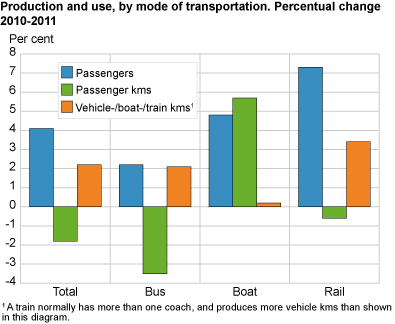Content
Published:
This is an archived release.
More and shorter fares
Almost 525 million trips were made by public transport in 2011. This is an increase of 20 million passengers from the previous year. Most of the growth was in the urban areas of Oslo, Bergen and Trondheim. City fares are shorter than other fares.
The total passenger figures for public transport have shown an increase of 4.1 per cent since 2010, and amounted to 525 million in 2011. Two out of three new passenger journeys were on rails, mostly by tram or the underground.
The increase in traffic for trams and the underground was 9.4 per cent. Boats had a more moderate increase in passengers, of 4.8 per cent, and bus and the railway passengers increased by about 2 per cent.
Cities lead the way
Most of the increase in passengers has been in urban areas, with the three largest cities leading the way. Oslo, Bergen and Trondheim had a growth of 10 million passengers, which is equal to the total increase in urban areas.
Buses lose passengers outside urban areas
Express buses had 7.0 per cent fewer passengers in 2011, and trips within counties, outside urban areas, decreased by 1.7 per cent.
Reduced transport performance
Despite the increase in the number of fares, total passenger kilometres decreased by 1.8 per cent from 2010 to 2011. Boat was the only exception, with a growth of 5.8 per cent. The average fare length was reduced by almost a kilometre to 14.6 kilometres. This was the result of a combination of fewer long trips and more short city fares.
Definitions of termsSeat kilometre: total number of kilometres that available seats have travelled. Passenger kilometre: total number of kilometres that the passengers have travelled. Transport performance: a generic term that, regardless of the context, denotes passenger kilometres or tonne kilometres. Distance driven: the total number of kilometres that the transport units have driven. A generic term that, regardless of the context, denotes vehicle kilometre, boat kilometre or train kilometre. |
Public transportPublic transport in this context covers all transport following a route by bus, rail, tram or boat. Aeroplanes, taxies, car ferries and Hurtigruta are not included. |
Uncertain time seriesBoth the bus and boat sectors have been subjected to major structural, contractual and technological changes in recent years. The postponement of tenders, gross contracts and electronic ticketing have all contributed to greater uncertainty in the changes in the supply and demand for public transport. In Bergen and Hordaland, changes were made to the calculation model for 2011. |
Tables:
Contact
-
Jardar Andersen
E-mail: jardar.andersen@ssb.no
tel.: (+47) 99 70 08 04

